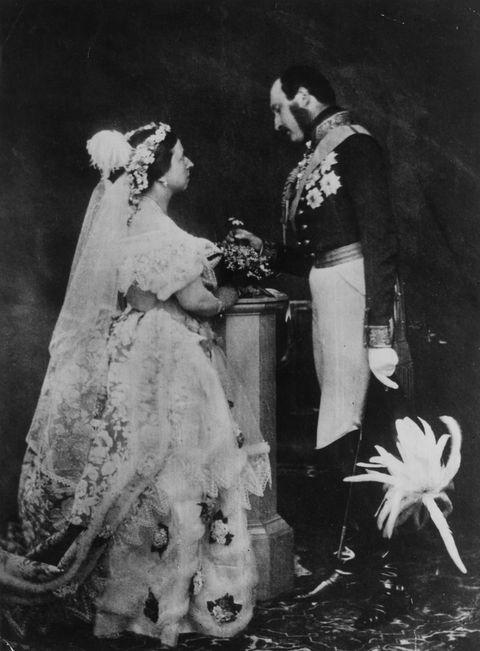Queen Victoria spent the majority of her reign wearing black, to mourn the death of her husband Albert. Yet, she is credited with kicking off a very different fashion trend: Brides wearing white on their wedding day.
After her wedding, Victoria wrote in her journal of her dress, "I wore a white satin gown with a very deep flounce of Honiton lace, imitation of old. I wore my Turkish diamond necklace and earrings, and Albert’s beautiful sapphire brooch." Little did the 21-year-old queen know that the white satin gown she wore would begin the trend of bridal dressing for centuries to come.
At the time of Queen Victoria's wedding to Prince Albert, it was common for wedding dresses to come in a variety of colors—but Victoria chose a white dress. White gowns were not popular, as keeping a white dress white after it was worn was exceedingly difficult. White outfits, therefore, were viewed as a sign of wealth.
There are competing theories on why Queen Victoria wore white. "Victoria had chosen to wear white mostly because it was the perfect color to highlight the delicate lace," writes Julia Baird in Victoria The Queen: An Intimate Biography of the Woman Who Ruled an Empire. She especially wanted to show off the lace to support lace makers in England.
"Before bleaching techniques were mastered, white was a rare and expensive color, more a symbol of wealth than purity," Baird wrote. "Victoria was not the first to wear it, but she made it popular by example. Lace makers across England were thrilled by the sudden surge in the popularity of their handiwork."
Historian Jennifer Steadman, however, believes Victoria chose white aware of its perception of innocence in the media. "She wanted to be seen as [Albert's] wife, so she didn’t wear the red ermine robe of state. She wore white. After that, all representations in...fashion magazines picked up on that. The white wedding dress became the standard symbol for innocence and romance," Steadman explains. Agnes Strickland’s 1840 biography of Queen Victoria backs up Steadman's theory on public perception: Strickland wrote Victoria was dressed on her wedding day "not as a queen in her glittering trappings, but in spotless white, like a pure virgin, to meet her bridegroom."
Victoria was not the first to wear a white dress on her wedding day, nor was she even the first royal woman (Mary, Queen of Scots wore white on her wedding day in 1558), but she certainly was the most influential. White wedding dresses quickly became the norm, not the exception, following Victoria's nuptials.


